World of Tanks news » The Chieftain's Hatch: Amphibious Ops Part 1

I am most please to again hand off the keyboard to a guest writer, and to see the return of author and historian Harry Yeide to the Hatch. This is the first of a multi-part series which will be posted up here over the coming couple of weeks, covering the US Army's experience in using tanks in amphibious operations during WWII. Over to you, Harry. - The Chieftain
Amphibious Operations Using Tanks
The U.S. Army drew a distinction in World War II between amphibious and amphibian operations and equipment. The amtanks and amtracs were amphibians—they could and did return to the water—that participated in broader amphibious operations. The Army also developed ways to use tanks amphibiously (as did the Marines), which was more typical.
Three broad approaches to using armor developed under the overarching joint-service doctrine for amphibious operations: the African/Mediterranean/European, the Central Pacific, and the Southwest Pacific models. At the time, the American military made no formal distinction between the approaches, and they merely emerge in restrospect. The key difference among them is how armor participated in the assault wave. The African/Mediterranean/European model relied on landing craft, and ultimately self-powered floating medium tanks, to get armor support to the infantry landing force, and it proved inconsistent in how quickly that happened. The Central Pacific model, designed to assault atolls surrounded by reefs that would hole a landing craft, utilized amtracs to deliver infantry and amtanks for direct armored support in the assault wave, followed by “land tanks” when the beach was secure. The Southwest Pacific commanders had no amtank battalions available and used landing craft and occasionally amtracs to put infantry ashore, followed closely by landing craft carrying tanks.
The Army and Navy anticipated that armor would play a role in amphibious assault operations as they geared up for what seemed increasingly likely involvement in a global war. As of 30 September 1941, the two services had obtained only forty-six tank landing craft, but they had 101 under construction and 131 funded and awaiting contract. Three hundred amphibian tractors were under construction, and 188 more were awaiting contract. The number of landing craft of all types available or under procurement was sufficient for three Army or Marine Corps triangular infantry divisions to land nine battalion combat teams each.
The Army was deeply involved in obtaining the wherewithal—transports and landing craft—to mount its own amphibious operations to be supported by the Navy, and as late as April 1942 it argued that it should be responsible for all amphibious operations in the Atlantic while the Marine Corps conducted those in the Pacific. Instead, the Amphibious Forces of the Atlantic and Pacific Fleets were established on 14 March and 10 April 1942, respectively, and the Navy took responsibility for getting troops onto hostile shores and training the men needed to do that.[i]
This series will address the evolution of the African/Mediterranean/European model. My amtank article pretty much covered the Central Pacific model.
More Forgotten Battalions
The amphibious assault was mainly the domain of the separate armored battalions. The separate tank, amphibian tank, or amphibian tractor battalions were present at every amphibious assault that the Army conducted where armor was used at all, while armored divisions participated in landings only in North Africa and Sicily.
Regular tank battalions destined for early amphibious operations practiced landing techniques well in advance. The Army had trained one infantry division on each coast for amphibious operations, the 1st Division on the east and the 3d Division on the west. Company A, 70th Tank Battalion, participated in secret amphibious maneuvers with the 1st Infantry Division between 17 June and 16 August 1941, which was the first such training for an American tank battalion. Combat elements underwent additional amphibious training with Amphibious Force in Norfolk, Virginia, during the spring and summer of 1942.[ii]
The 756th Tank Battalion at that same time underwent amphibious training at Ft. Ord, California, with the 3d Infantry Division, with which it would land in North Africa.[iii] Then-Lieutenant David Redle, a twenty-three-old ROTC graduate from Wyoming, recalled that his Company B was attached to the 3d Division on 1 October 1941 and first shipped to Tacoma to qualify all the men as swimmers and to conduct initial training with light tanks in Higgins boats, also known as tank lighters. The plywood vessels had a ramp on the front that went down on the beach and allowed men or a vehicle to exit. Upon arriving at Ft. Ord, odd-looking wading stacks or shrouds were attached to the backs of the waterproofed M5 light tanks in order to keep water out of the air intake and exhaust when in the surf.[iv]
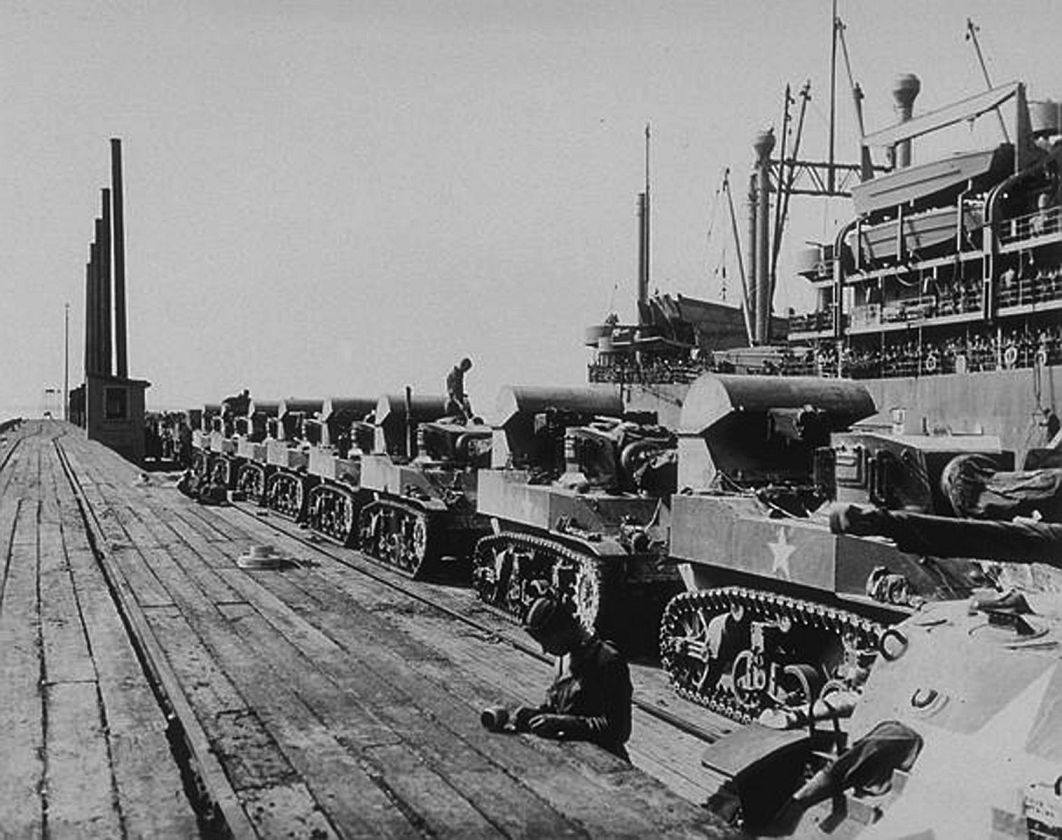 M5 light tanks belonging to the 756th Tank Battalion (Light) await loading for the journey to North Africa for Operation Torch. They are waterproofed and fitted with wading stacks much like those that will be used in amphibious landings for the rest of the war.
M5 light tanks belonging to the 756th Tank Battalion (Light) await loading for the journey to North Africa for Operation Torch. They are waterproofed and fitted with wading stacks much like those that will be used in amphibious landings for the rest of the war.
*
Amphibious doctrine as of 1938 specified certain requirements for amphibious landings, all subject to the general principles of war, such as the desire for surprise: The beaches had to be good from the landing fleet point of view, and the interior from the land force perspective. Naval gun and aviation had to control the area of the objective, damage or weaken resistance on the shore, and support ground forces moving inland. The landing force had to have a reasonably secure line of communication. As soon as the action ashore moved from amphibious warfare to land warfare, the Army was to relieve the Marines. In the eyes of Admiral Richmond “Kelly” Turner, who commanded numerous operations in the central and south Pacific, the only substantial change to occur in amphibious doctrine during the war was to the last element, because the Army threw itself so deeply into amphibious operations.[v]
North Africa: Operation Torch
The separate tank battalions had a numerically small but tactically important role in Operation Torch, the Allied landings in North Africa on 8 November 1942. The Army intended to use two light tank battalions in the role that amphibian tanks would play in the later stages of the war in the Pacific: To help secure an initial foothold through which following waves of troops and heavier tanks could pass to wage battle inland. It was imperative that troops rapidly clear the beach as they landed, which meant that the infantrymen would need all the firepower they could get to overwhelm initial resistance at the shore. That meant tanks. The aim was to establish a beachhead, which Army amphibious doctrine—crafted jointly with the Navy—defined as a position organized in depth, with a view to offensive or defensive operations, which protected the beach initially from enemy light artillery fire (range about 10,000 yards) and eventually from medium artillery (range about 15,000 yards).[vi]
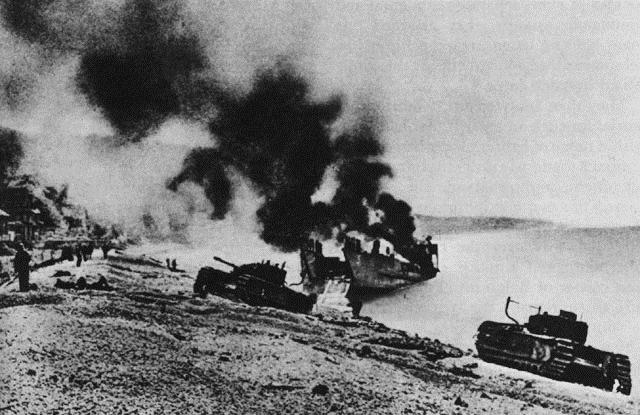 Canadian tanks at Dieppe.
Canadian tanks at Dieppe.
The sum total of Allied experience in assaulting a defended shore using tanks was the raid at Dieppe, France, in August 1942. The affair was viewed by many as bloody failure—3,400 of the 5,000 men involved were casualties or taken prisoner and twenty-eight tanks were lost or left behind.[vii]
Technological limitations in sealift left few options for planners. The infant Allied amphibious force was capable of landing only light tanks aboard available tank lighters, as the medium tanks were too heavy. In the American fleet, the tanks had to be lifted from the holds of transports by cranes and lowered into the lighters waiting alongside.[viii] The M5s available to the light tank battalions assigned to Western Task Force, which was to invade French Morocco, were waterproofed, with hooded shrouds attached over the air intake and exhaust so the tanks could run through four-to-five-foot-deep water after leaving the lighters.[ix] Medium tanks had to be offloaded at dockside once the infantry and light tanks had secured port facilities.
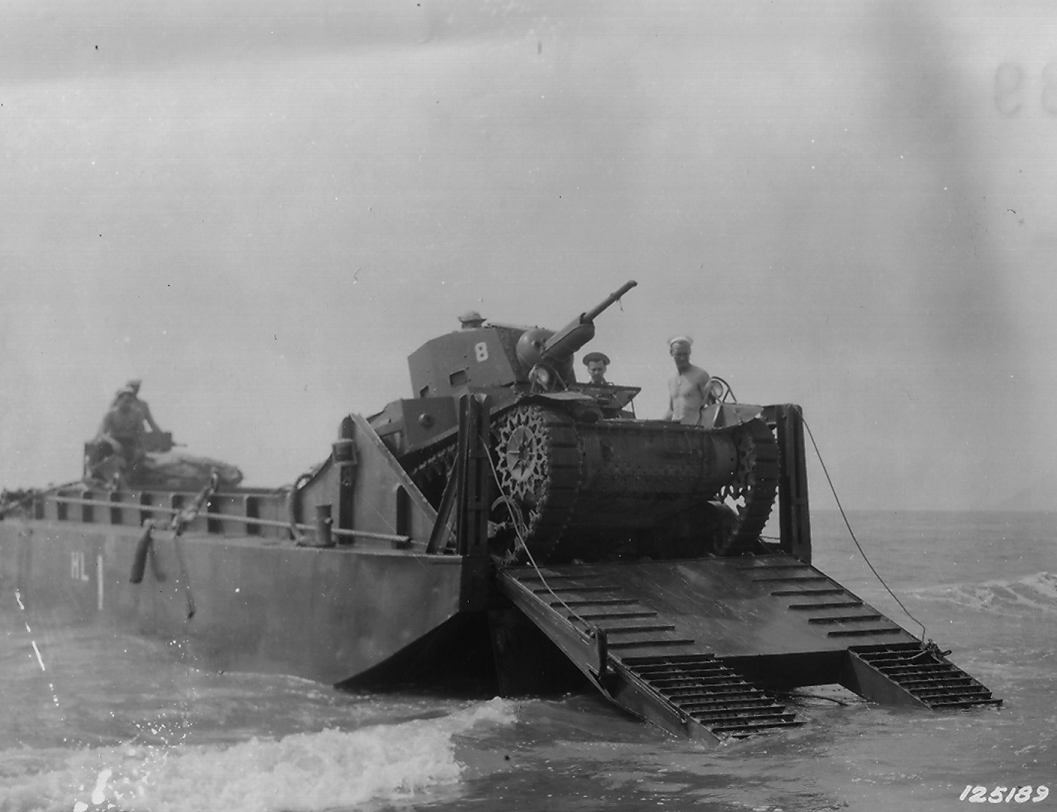 Early tank lighters could only carry light tanks.
Early tank lighters could only carry light tanks.
David Redle, 756th Tank Battalion (Light), who had experienced loading many times in training, described the process: “Each time the operation took place at night in blackout conditions. They used the ship boom and a winch. The winch operator watched the man next to the edge of the ship. He had to move the tank down to the waiting Higgins boat. He had to be in synch with the boat moving up and down with the swell. If they were out of synch, the thirteen-ton tank would smash the boat. The tank crew was in the bow of the boat. As soon as the tank was in the boat, they moved away from the ship.”[x]
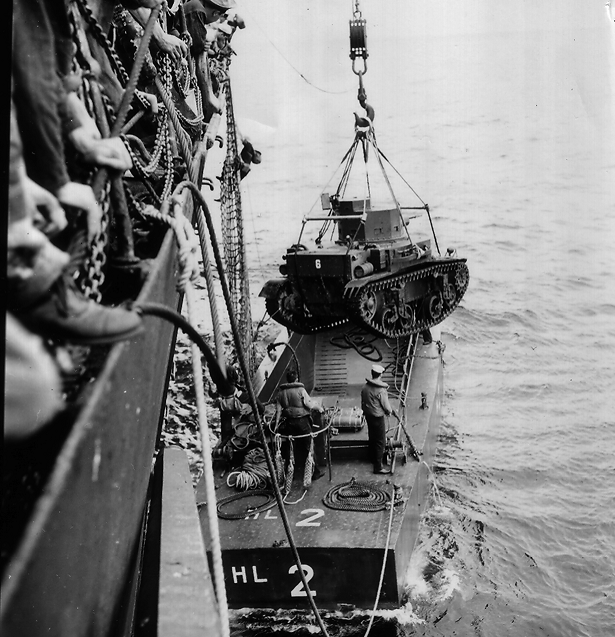 Vessels had to lower the light tanks, in this case an M2A4, into the lighters by crane.
Vessels had to lower the light tanks, in this case an M2A4, into the lighters by crane.
Casablanca, the prize in French Morocco, was too strongly defended to be taken by frontal assault, so planners selected from among the small ports north and south of Casablanca two just big enough to handle medium tanks unloaded from transport ships—Port Lyautey and Safi, respectively. As Safi was 150 miles southwest of Casablanca and Port Lyautey fifty miles to the northeast, infantry and light tanks were to land at Fedala, only eighteen miles northeast of Casablanca, and wait for the medium tanks to arrive.[xi]
Planners adopted another strategy for the landings by Task Force Center at Oran, Algeria, where no ports would be immediately available in the target areas of coast. The 1st Infantry Division was to clear the way for Combat Command B, 1st Armored Division, to land its men and light tanks from Maracaibo transport ships (converted oil tankers).[xii] The Maracaibos required seven feet of draft, so pontoon bridges were to be constructed—a task requiring three hours—over which vehicles were to drive to shore.[xiii] Once the port of Arzew was captured, the medium tanks, which were too large for the Maracaibos, were to disembark.[xiv]
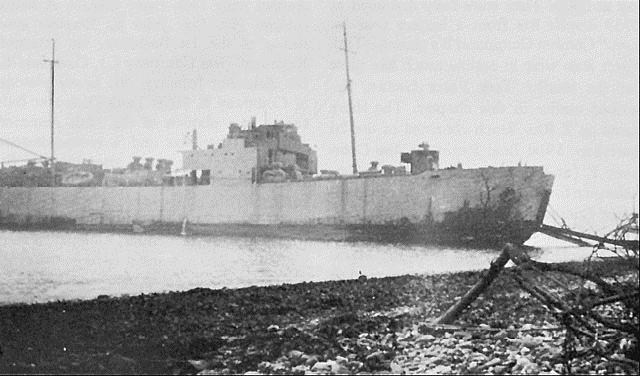 A converted Maracaibo oil tanker used as a tank carrier.
A converted Maracaibo oil tanker used as a tank carrier.
For the eastern-most Allied landings around Algiers, the 9th and 34th Infantry divisions had contributed one regimental combat team each—the 168th and 39th, respectively—to what was a British-majority enterprise.[xv] One company from the 70th Tank Battalion (Light) was attached to the 39th Infantry for the operation, but no American medium tanks were to participate.
The armored force that was to land in Morocco was the best equipped in the Allied invasion force, despite being farthest from the ultimate objective in Tunisia, because its components deployed from the States and had been able to absorb new equipment until shortly before departure. Where the 70th and 756th Tank battalions had new M5s, the 1st Armored Division, which had shipped out from the UK, retained M3s. The 2d Armored Division fielded the new M4 Sherman medium tank, as well as the M5 light tank. The 1st Armored Division went into battle with M3 medium tanks.
*
Fleet Tactical Publication No. 167, the “Bible” of landing operations doctrine published by the Navy in 1941, had stipulated that the landing area was to be prepared by air and naval bombardment so that troops could seize the shore with confidence. On 7 August at Guadalcanal, the first American amphibious offensive of the war (it invololved no tanks), three cruisers and four destroyers—nearly all the firepower available for the operation from the over-stretched, post-Pearl Harbor Pacific Fleet—had bombarded the invasion beaches for seven minutes before the landing craft reached the sand.[xvi] For political reasons, Operation Torch, the second amphibious offensive, violated this basic tenet of doctrine. Planners hoped the French would not resist vigorously, and there would be no massive bombardment of French soil. Naval units were to fire only when requested to by ground forces, at any searchlights, and at any shore batteries that began shooting.[xvii]
*
The 70th Tank Battalion entered Africa with the widely scattered regiments of the 9th Infantry Division. The division was split between the eastern and western task forces, and its 39th Infantry was to land nearly 600 miles east of the 47th and 60th Infantry regiments. Even within the western task force’s zone, the 9th Division was spread out, and its regiments were to land well to the north and south of Casablanca. So, too, were the tankers, parceled out one company to each regiment.
Major General Ernest Harmon, commanding general of the 2d Armored Division, directed the sub-task force that was to capture Safi, which included the 47th Infantry Regiment. Company B, 70th Tank Battalion, was attached to the 47th Infantry’s assault wave, which was to clear the way for Combat Command B, 2d Armored Division, to disembark medium tanks at the docks in Safi. Combat Command B included M4 Shermans from the 2d Battalion (reinforced) of the 67th Armored Regiment.[xviii]
Landing operations commenced shortly after midnight. The limited training and inexperience of the Western Naval Task Force combined with a heavy swell off shore to cause delays in hoisting the light tanks and other gear into lighters. One platoon of Company B’s light tanks joined the 1st Battalion Landing Team, which sailed into Safi harbor to seize control of high ground just outside of town while special landing groups secured the wharves. Only three of the tank lighters managed to reach Green Beach, and all three tanks were immobilized, one by a drowned motor, one by a faulty battery, and one by soft sand, and the riflemen had to advance under fire without their tank support.[xix] The 1st Platoon’s tanks, however, reached shore at 0500 with the 47th Reconnaissance Platoon; half the command moved into Safi, seized the telephone and telegraph exchange, and knocked out an antitank gun near the post office.
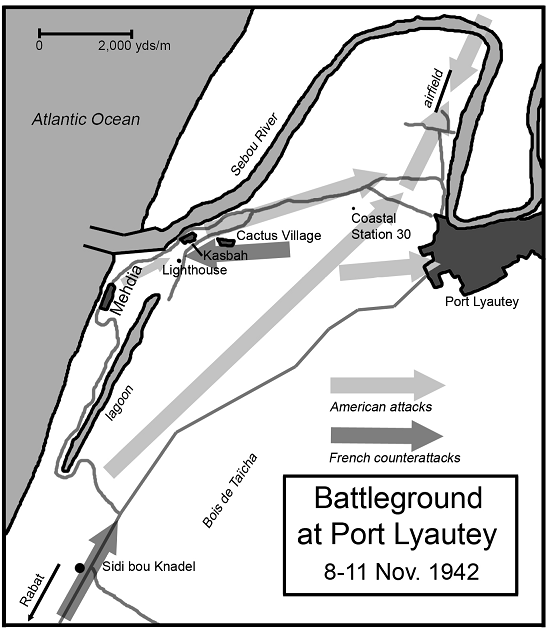
The 9th Division’s 60th Regiment, meanwhile, was to land well northeast of Casablanca. At 0130 hours off Port Lyautey, Company C, 70th Tank Battalion, left the transports with the 60th Infantry Regiment as part of Force Goalpost, the main objective of which was to capture an airfield near the port. Twelve tanks were put ashore—one tank swamped with the loss of all crewmen—and the Americans easily established a beachhead.
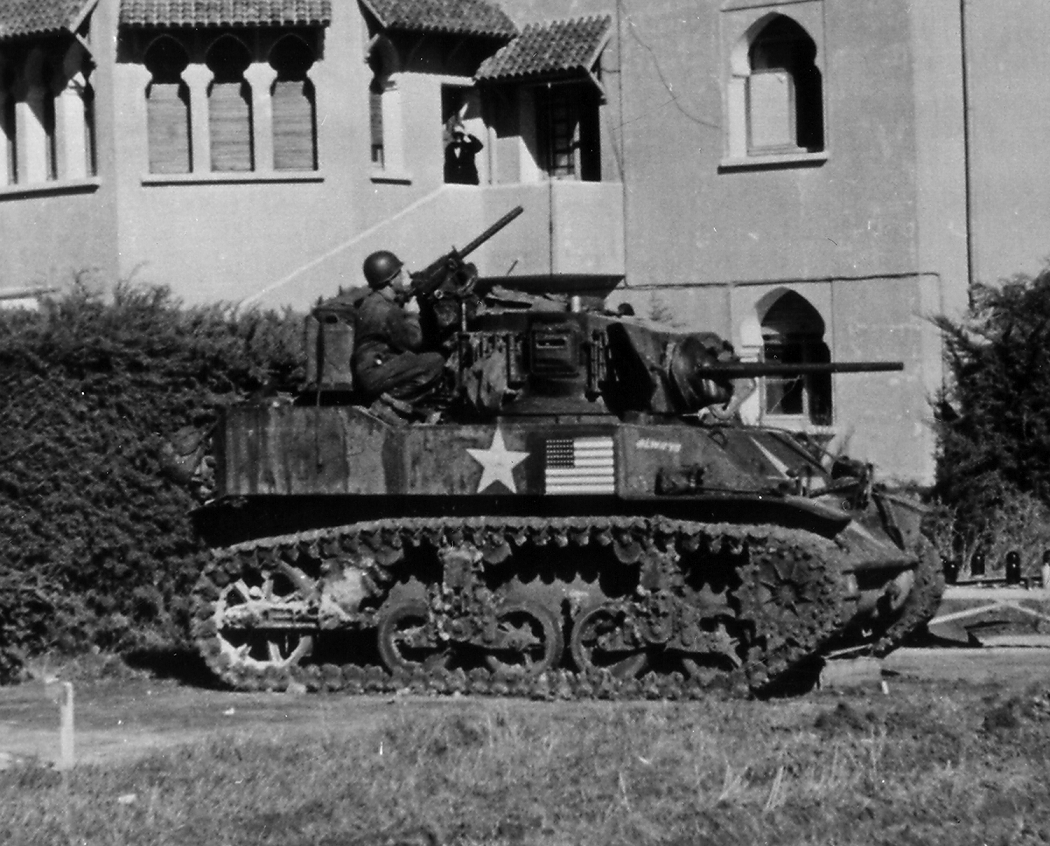 A 70th Tank Battalion M5 at Casablanca Airport on 17 November 1942.
A 70th Tank Battalion M5 at Casablanca Airport on 17 November 1942.
Planners knew that the French regiment defending the airfield could be reinforced by a battalion of forty-five light tanks by late on D-day, and by another half battalion the next day. Brig. Gen. Lucian Truscott, commanding the 60th Infantry, had known he would need tanks of his own, and in addition to Company C, he had a battalion-sized landing team from the 2d Armored Division’s 66th Armored Regiment assigned. The armor was to guard the south flank, effectively Truscott’s rear once he was able to drive on the airfield.
The 60th Infantry Regiment was unable to secure all of its D-day objectives, notably the Kasba, a walled fortress straight out of Beau Geste. A shortage of lighters had allowed only seven M5s from the 66th Armored Regiment to reach the beach. Ominously, French troops appeared from the direction of Rabat before nightfall, supported by Renault light tanks.[xx]
*
Companies A and C, 756th Tank Battalion (Light), landed with the 3d Infantry Division at Fedala—the main landing for the capture of Casablanca—to be followed by the 1st Battalion, 67th Armored Regiment. Company B had been left at Camp Picket for lack of shipping space. The command collectively was known as Brushwood Force. Then-Col. Ben Harrell, who functioned as II Corps and then 3d Infantry Division G-3 during the planning phase, said, ”Well, of course this was the first time any of us had done it, and we made our mistakes in our plans and carrying them out. . . . I made the small boat employment plan, and on paper it looked pretty good, but the thing was too damned complicated. . . . When we were coming in to land, the whole task force was scattered all over hell.”[xxi]
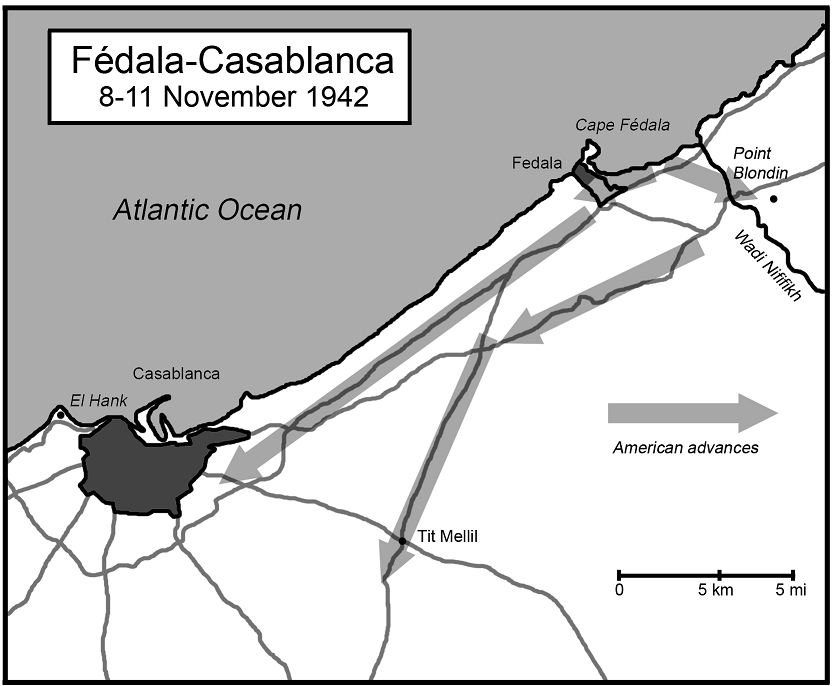
Indeed, the plan called for each battalion landing team to be supported by between forty-three and forty-five personnel landing craft and from five to nine tank lighters.[xxii] The landing craft were loaded with tank-infantry teams rather than just vehicles. Each had a single M5 tank aboard, plus fifty infantrymen.[xxiii] As it turned out, the Navy and Army commanders agreed that the convoy was too disarranged for the plan to ever work, and they ordered transports to unload troops into whatever landing craft were available, which meant that most formations arrived on shore incrementally.
The neophyte character of the American amphibious capability became clear to the tankers almost immediately. Second Lieutenant John Rutledge, commanding the 2d Platoon, Company A, heard the wave commander and the coxswain talking at the back of the landing craft, and by and by the coxswain asked Rutledge whether any of his men could read a compass. Fearing he might lose a man to the Navy, Rutledge disingenuously replied no. The Navy turned the assault wave 180 degrees about and started, the commander imagined, toward the beach. A destroyer loomed out of the dark, and its crew warned that the assault wave was headed toward South America. A turnabout put the landing force in the right spot, but late and in a confused state.[xxiv]
The landings were a disaster in terms of lost landing craft at the hands of inexperienced crews, and drowned infantrymen, dragged to the bottom by their heavy loads.[xxv] Only five light tanks reached shore, but fortunately the French had few tanks of their own in the area.[xxvi]
Those five tanks—Rutledge and his platoon—rolled off the tank lighters at about 0830 under fire from coastal defense guns on and near Cape Fedala and quickly became engaged just as the Army had intended the infantry tanker to be. The tanks drove off the beach, crossed a low hill, and stopped so the crews could remove the waterproofing. Colonel William Wilbur, commanding the 7th Infantry Regiment, drove up. He introduced himself and said there were some guns in Fedala that were shooting up his boys, and asked what the tankers were going to do about it. Some readers will be relieved to know that there ensued a brief discussion of doctrine and its relationship to real-world battlefield needs. Rutledge described what happened:
I informed him that our 1st Platoon was supposed to be handling that part of it, and that Armored Force tactics frowned upon taking tanks into towns. He said that we were the only tanks on shore at that time, and that we were the only ones to do the job. He outlined the situation and said, “Lets go get them.”
One of my tanks had strayed away after landing. However, the remaining four tanks proceeded toward Fedala. Colonel Wilbur rode on the outside of my tank. . . . We proceeded into town, where we met Lt. Col. [Roy] Moore, 1st Battalion, 7th Infantry Regiment. Watches were coordinated and arrangements made to meet the infantry battalion in front of the guns in twenty minutes. . . .
At this time, my platoon sergeant’s tank “shorted” out. The remaining three tanks proceeded to a point in the formal gardens back of the church there, where we took up defilade positions behind the hedge and opened fire on some guns in the southwest portion of Fedala near the harbor master’s house. . . .
Colonel Wilbur and I went forward on foot to some houses just west of Rue de Reims to reconnoiter. While climbing atop a house in order to better observe the situation, we were fired on by an enemy machine gun, the bullets passing between Colonel Wilbur’s feet and over my head. We returned to the ground. . . .
Upon arriving at the last row of buildings in front of the guns, I lost track of Colonel Wilbur. I looked over the situation and found the infantry under fire from pillboxes. Two of the three tanks reduced the pillboxes and snipers’ positions, while the remaining tank crashed through the barbed wire barricade, thus opening the position to the infantry.[xxvii]
The French 100-mm gun battery surrendered. Wilbur was awarded the Medal of Honor for this and several other acts of bravery during the landing.[xxviii]
The 7th and 15th Infantry regimental landing groups received orders at 1600 to advance on Casablanca. In the 7th Infantry’s zone, the light tanks from the battalion landing teams were pulled back into regimental reserve near the command post (CP), and nine more from Company C were shifted there from the 30th Infantry Regiment.[xxix]
[i] Vice Admiral George Carroll Dyer, The Amphibians Came to Conquer: The Story of Admiral Richmond Kelly Turner, online version, Hyperwar website, http://www.ibiblio.org/hyperwar/USN/ACTC/index.html as of November 2007, 209-216. (Hereafter Dyer.)
[ii] Hall, 18, 21.
[iii] Fazendin, xv.
[iv] David Redle, letter to author, January 2008. (Hereafter Redle.)
[v] Dyer, 224-225.
[vi] Landing Operations on Hostile Shores, FM 31-5, 2 June 1941.
[vii] Lt. Gen. Lucian K. Truscott, Command Missions (New York: E. P. Dutton and Company, Inc., 1954), 18ff. (Hereafter Truscott.)
[viii] Hall, 30.
[ix] Jensen, 19. “The 756th Tank Battalion” website, photographs, http://www.756tank.com/ as of October 2007. Col. Harry Roper, “Report on Observations Made as Observer with Task Force Brushwood (3d Division Landing at Fedala and Subsequent Attack on Casablanca, French Morocco),” undated. Included in “Report of Observers: Mediterranean Theater of Operations,” Volume 1, 22 December 1942-23 March 1943. (Hereafter Roper.)
[x] Redle.
[xi] George F. Howe, Northwest Africa: Seizing the Initiative in the West: United States Army in World War II, The Mediterranean Theater of Operations (Washington, DC: Center of Military History, United States Army, 1993), 40-41. (Hereafter Howe.)
[xii] AAR, 1st Infantry Division. “Summary of Lessons Derived from Amphibious Operations, November 8-11 1942, at Casablanca and Oran,” 25 February 1943.
[xiii] “Observer Report,” 5 March 1943. Included in “Report of Observers: Mediterranean Theater of Operations,” Volume 1, 22 December 1942-23 March 1943.
[xiv] Howe, 49.
[xv] Howe, 53.
[xvi] Dyer, 208, 342-343.
[xvii] Roper.
[xviii] Hall, 20.
[xix] Howe, 103-107.
[xx] History, 70th Tank Battalion. Capt. Joseph B. Mittelman, Eight Stars to Victory: A History of the Veteran Ninth U.S. Infantry Division (Washington, DC: The Ninth Infantry Division Association, 1948), 64. Hall, 25-26. Howe, 147ff.
[xxi] “US Army Military History Research Collection, Senior Officers Debriefing Program: Conversation Between General Ben Harrell and Col. Robert T. Hayden,” US Army Heritage Collection OnLine, http://www.ahco.army.mil/site/index.jsp as of August 2007. (Hereafter Harrell.) Redle.
[xxii] Howe, 124.
[xxiii] Conway.
[xxiv] Fazendin, xxi.
[xxv] Howe, 125-127.
[xxvi] Roper. Rick Atkinson, An Army at Dawn (New York: Henry Holt and Company, LLC, 2002), 156. (Hereafter Atkinson, An Army at Dawn.)
[xxvii] Account contained in folder “Rpts of Units of 3rd Div in the Casablanca Opns,” 3d Infantry Division history files, NARA.
[xxviii] Howe, 128. Medal of Honor citation.
[xxix] AAR, 7th Infantry Regiment. AAR, 30th Infantry Regiment.















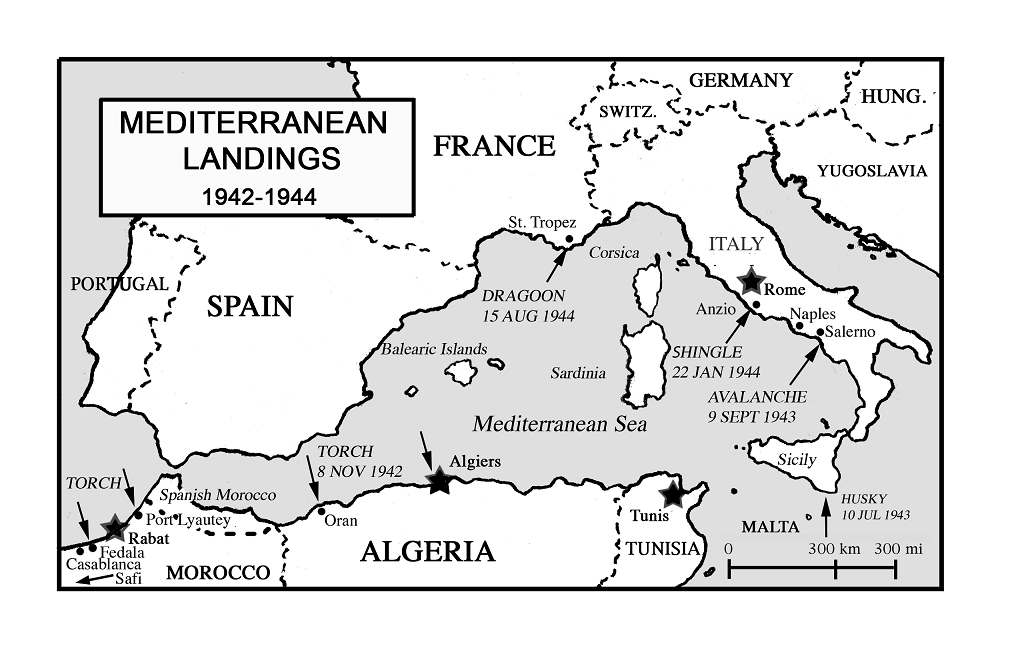
 Update comments
Update comments